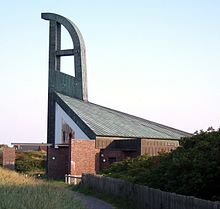Lucy Hillebrand
Lucy Hillebrand (born March 6, 1906 in Mainz , † September 14, 1997 in Göttingen ) was a German architect .
Life
Lucy Hillebrand was the daughter of Fides Laura, b. Mayer , and the Mainz forwarding agent Hans H. Hillebrand . After attending a reform school, she attended the secondary school for girls in Mainz from 1915 to 1922 . She studied from 1922 to 1925 at the Kunstgewerbeschule in Offenbach am Main (today HfG Offenbach ) and from 1925 to 1927 at the Werkkunstschule in Cologne with Dominikus Böhm . From 1928 she had her own office in Frankfurt am Main . In 1927 she became the youngest member of the Deutscher Werkbund and in 1932/1933 she was the only woman to take part in its second settlement project in Stuttgart . ( Deutsches Holz - Kochhofsiedlung , under the direction of Richard Döcker ). After 1933 she worked for the Bensen house in Göttingen . After 1934 she was no longer able to practice her profession and was also personally at risk because her mother was Jewish. She committed suicide in 1942 to avoid the threat of deportation to Theresienstadt .
After 1945, Lucy Hillebrand founded a studio in Göttingen , in which she dealt intensively with the construction of schools and education.
In Göttingen after the war, several private buildings were also built according to their designs, almost all of which bear the same signature. The villa of doctor Wolfgang Bieker in Bovenden, built in 1955, is a particularly successful design.
Lucy Hillebrand was married to Erich Gerlach .
Works (selection)
- Educational advice center in Hanover (1953/56),
- Trade union building in Northeim (1958),
- Church of St. Nicholas on the North Sea island Langeoog (1950)
- Psychotherapeutic Clinic in Tiefenbrunn (1969),
- Albert Schweitzer Children's Village in Uslar (1970)
Exhibitions
- 1991: Space games - play spaces. Architectural drafts and models in the Hidden Museum , Berlin
- 1994: “The incomplete architecture”, exhibition of the German Werkbund in the Sprengel Museum in Hanover
- 1996: Exhibition in the Künstlerhaus Göttingen
- 2017: "Frau Architekt" German Architecture Museum in Frankfurt am Main with works by Lucy Hillebrand
Honors
In 1982 the Prime Minister of Lower Saxony awarded her the Cross of Merit 1st Class of the Lower Saxony Order of Merit.
In 1985 she received honorary membership of the German Werkbund.
In 1987 she became an honorary member of the Association of German Architects .
In 2009 a street was named after her in Mainz; the University of Mainz has its headquarters there.
literature
- Ute Maasberg, Regine Prinz: The new ones are coming! Female avant-garde in the architecture of the twenties. Junius Verlag, Hamburg, undated (2004), pp. 90f., ISBN 3-88506-550-9 .
- Ulrich Krempe: Lucy Hillebrand. Th. Schäfer, Hanover, 1996, ISBN 3-88746-351-X .
- Christian Grohn (Ed.): Lucy Hillebrand - Building as an Impulse. Gebr. Mann Verlag, Berlin, 1990, ISBN 3-7861-1601-6 .
- Klaus Hoffmann: Lucy Hillebrand. Paths to space. Fotografie-Verlag, Göttingen, 1985, ISBN 3-921907-09-8 .
- Gottfried Borrmann: The consciously perceived space. The Mainz architect Lucy Hillebrand and the reform movement. In Mainz. Quarterly books for culture, politics, economy, history 8 (1988), no. 1, pp. 66–70.
- Dieter Boeminghaus: Time-Spaces by the architect Lucy Hillebrand. Karl Krämer Verlag, Stuttgart, 1983, ISBN 3-7828-1110-0 .
- Women's life in Magenza. The portraits of Jewish women from the Mainz women's calendar and texts on women's history in Jewish Mainz, Mainz 2010.
Web links
- Literature by and about Lucy Hillebrand in the catalog of the German National Library
- Lucy Hillebrand at Deutscher Werkbund.de
- Appreciation at Fembio.org
- Edeltraud Haselsteiner: The architect Lucy Hillebrand. An interdisciplinary dialogue about SPACES as a way to socially design spaces , dissertation concept, TU Wien, 2005 ( link to the expose with curriculum vitae and list of works )
- Video of a lecture given by Lucy Hillebrand in 1989
- Isabel Schulz, Sprengel-Museum Hannover: "A kind of work ... that a man cannot do". Artists around Kurt Schwitters , lecture ( link to the lecture at sprengel-museum.de )
Individual evidence
- ↑ a b c website of the Deutscher Werkbund , accessed on August 15, 2018
- ↑ Overview for March 1996 at Wiki-Göttingen , accessed on August 16, 218
- ↑ Review in the Stuttgarter Nachrichten of December 18, 2017, online edition , accessed on August 15, 2018
- ^ Chronicle for 1982 of the Göttingen City Archives , accessed on August 16, 2018
- ↑ Link to Emil Händlers lecture on the occasion of the street naming with examples of Lucy Hillebrand's works , accessed on August 15, 2018
| personal data | |
|---|---|
| SURNAME | Hillebrand, Lucy |
| BRIEF DESCRIPTION | German architect |
| DATE OF BIRTH | March 6, 1906 |
| PLACE OF BIRTH | Mainz |
| DATE OF DEATH | September 14, 1997 |
| Place of death | Goettingen |
